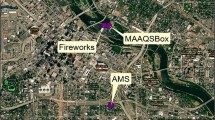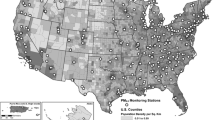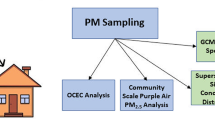Abstract
In ambient particle source apportionment studies, data for holidays such as July 4 (US Independence Day) are normally removed because of the high concentrations of chemical species and unusually high particle mass concentrations that are due to fireworks. Many cultures celebrate events with fireworks. A near real-time measurement that could indicate fireworks would be useful in indicating their impact on air quality. Commonly monitored ambient pollutants include PM2.5, CO, SO2, O3, 10–500-nm particle number, and black carbon (BC). Using a two-wavelength aethalometer, another parameter, delta-C (UVBC370 nm–BC880 nm, aethalometer), can be calculated. These variables were continuously monitored during July 1–7, 2005–2010, in Rochester, New York. High delta-C values are normally associated with biomass combustion particles. However, statistically higher delta-C values were observed on Independence Day compared to the other period. Back trajectory analysis showed transport of local fireworks smoke to the sampling site on the night of July 4. An enhanced correlation between delta-C and BC during the fireworks episodes suggests changes from the usual BC sources. Fireworks emissions changed the ambient carbonaceous particulate species during these intervals. The delta-C value was found to be a readily measured indicator of fireworks emissions during periods when wood combustion was not likely to be present and provides a tool for monitoring such emissions where they might be more common such as amusement parks.

Similar content being viewed by others
References
Andreae, M. O., & Merlet, P. (2001). Emission of trace gases and aerosols from biomass burning. Global Biogeochemical Cycles, 15(4), 955–966.
Barman, S. C., Singh, R., Negi, M. P. S., & Bhargava, S. K. (2009). Fine particles (PM2.5) in ambient air of Lucknow city due to fireworks on Diwali festival. Journal of Environmental Biology, 30(5), 625–632.
Camilleri, R., & Vella, A. J. (2010). Effect of fireworks on ambient air quality in Malta. Atmospheric Environment, 44, 4521–4527.
Croteau, G., Dills, R., Beaudreau, M., & Davis, M. (2010). Emission factors and exposures from ground-level pyrotechnics. Atmospheric Environment, 44, 3295–3303.
Harrad, S., & Laurie, L. (2005). Concentrations, sources and temporal trends in atmospheric polycyclic aromatic hydrocarbon in a major conurbation. Journal of Environmental Monitoring, 7, 722–727.
Hirai, K., Yamazaki, Y., Okada, K., Furuta, S., & Kubo, K. (2000). Acute eosinophilic pneumonia associated with smoke from fireworks. Internal Medicine, 39, 401–403.
Hopke, P. K. (2007). Rockets red glare. InPark, 3(2), 26–29.
Moreno, T., Querol, X., Alastuey, A., Amato, F., Pey, J., Pandolfi, M., et al. (2010). Effect of fireworks events on urban background trace metal aerosol concentrations: Is the cocktail worth the show? Journal of Hazardous Materials, 183, 945–949.
Murty, O. P. (2000). Diwali toxicity. Journal of Forensic Medical and Toxicity, 17, 23–26.
Sarkar, S., Khillare, P. S., Jyethi, D. S., Hasen, A., & Parween, M. (2010). Chemical speciation of respirable suspended particulate matter during a major firework festival in India. Journal of Hazardous Materials, 184, 321–330.
Vecchi, R., Bernardoni, V., Cricchio, D., D'Alessandro, A., Fermo, P., Lucarelli, F., et al. (2008). The impact of fireworks on airborne particles. Atmospheric Environment, 42, 1121–1132.
Virkkula, A., Mäkelä, T., Hillamo, R., Yli-Tuomi, T., Hirsikko, A., Hämeri, K., et al. (2007). A simple procedure for correcting loading effects of aethalometer data. Journal of the Air & Waste Management Association, 57, 1214–1222.
Wang, Y., Zhuang, G., Xu, C., & An, Z. (2007). The air pollution caused by the burning of fireworks during the lantern festival in Beijing. Atmospheric Environment, 41, 417–431.
Wang, Y., Huang, J., Zananski, T. J., Hopke, P. K., & Holsen, T. M. (2010). Impacts of the Canadian forest fires on atmospheric mercury and carbonaceous aerosols in northern New York. Environmental Science & Technology, 44, 8435–8440.
Wang, Y., Hopke, P. K., Chalupa, D. C., & Utell, M. J. (2011a). Long-term study of urban ultrafine particles and other pollutants. Atmospheric Environment, 45(40), 7672–7680.
Wang, Y., Hopke, P. K., Rattigan, O. V., & Zhu, Y. (2011b). Characterization of ambient black carbon and wood burning particles in urban areas. Journal of Environmental Monitoring, 13, 1919–1926.
Wang, Y., Hopke, P. K., Rattigan, O. V., & Xia, X. (2011c). Characterization of residential wood combustion particles using the two-wavelength aethalometer. Environmental Science & Technology, 45(17), 7387–7393.
Wang, Y., Hopke, P. K., & Utell, M. J. (2011d). Urban-scale spatial-temporal variability of black carbon and wood burning particles. Aerosol and Air Quality Research, 11, 473–481.
Wilkin, R. T., Fine, D. D., & Burnett, N. G. (2007). Perchlorate behavior in a municipal lake following fireworks displays. Environmental Science & Technology, 41, 3966–3971.
Zhang, M., Wang, X., Chen, J., Cheng, T., Wang, T., Yang, X., et al. (2010). Physical characterization of aerosol particles during the Chinese New Year's firework events. Atmospheric Environment, 44, 5191–5198.
Acknowledgments
This work was supported by the United States Environmental Protection Agency (US EPA) through the University of Rochester PM and Health Center Grant RD832415, the New York State Energy Research and Development Authority (NYSERDA), and the New York State Department of Environmental Conservation (NYSDEC). Although the research described in this work has been partly funded by the US EPA, it has not been subjected to the agency's required peer and policy review and therefore does not necessarily reflect the views of the agency, and no official endorsement should be inferred. The authors gratefully acknowledge the NOAA Air Resources Laboratory (ARL) for the provision of the HYSPLIT transport and dispersion model and/or the READY website (http://www.arl.noaa.gov/ready.html) used in this work. The authors also thank Mr. David C. Chalupa from the University of Rochester Medical Center for collecting SMPS data.
Author information
Authors and Affiliations
Corresponding author
Electronic supplementary materials
Supplementary data associated with this article can be found in the online version.
ESM 1
(DOCX 1193 kb)
Rights and permissions
About this article
Cite this article
Wang, Y., Hopke, P.K. & Rattigan, O.V. A new indicator of fireworks emissions in Rochester, New York. Environ Monit Assess 184, 7293–7297 (2012). https://doi.org/10.1007/s10661-011-2497-5
Received:
Accepted:
Published:
Issue Date:
DOI: https://doi.org/10.1007/s10661-011-2497-5




